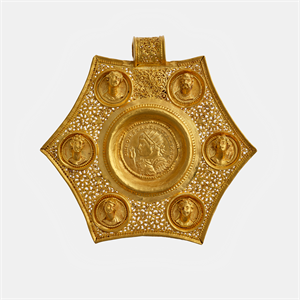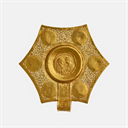Description
The consummate skill used to create this pendant places it among the most highly accomplished examples of gold jewelry from the early Byzantine period. The elaborate frame around the imperial medallion combines two techniques: chisel cutting of sheet gold masterfully worked to create lacelike tendrils, scrolls, and geometric designs; and hollow, three-dimensional heads formed by working the gold from both the interior and the exterior. The contrast of flat, silhouette patterns and heads in the round produces a dynamic counterpoint rarely seen in jewelry of this period.
The medallion shows the emperor Constantine wearing a crown of rays—an attribute of Apollo—while his sons Crispus and Constantine II are in consular robes on the reverse, co-celebrating their second consulate in 321. A similarly designed, although circular, pendant at Dumbarton Oaks contains a medallion celebrating the third consulate in 324 of these same imperial sons. In mint condition, these medallions were never put into circulation; they were framed so that both sides are visible, allowing all the imperial portraits to be seen. Despite their different shapes, the shared techniques, style, and decorative schemes confirm that these pendants were made as part of a set. Three additional pendants belong to this set judged by medallion type, techniques, designs, and superb execution: a circular pendant (Musée du Louvre, Paris); a hexagonal pendant (British Museum, London); and a slightly larger octagonal pendant (Cleveland Museum of Art). This latter pendant must have been the center piece of the most resplendent suite of gold jewelry to survive from early Byzantium.
The pendant and its companion pieces may have been an award from an emperor to an outstanding general or high ranking official, although their exact function is not certain The key to interpreting their historical and political significance, including the identification and meaning of the busts, has yet to be discovered.
- S. Zwirn
Bibliography
Catalogue of ancient jewellery, Classical, Celtic, Egyptian and Western Asiatic Antiquities and an Important Group of Early Byzantine Gold Medallions, Coins and Jewellery, from Various Sources: which will be sold at auction by Christie, Manson & Woods... Monday, October 19, 1970 (London, 1970), no. 197.
P. Bastien, "Les multiples d’or, de l’avènement de Dioclétien à la mort de Constantin," Revue Numismatique sér. 6 14 (1980): 49-82, esp. 63 n. 4, 72, no. 46.
C. Metzger, "Les biloux monétaires dans l'Antiquité tardive," Les Dossiers de l'archéologie 40 (1980): 82-90, esp. 87-88, fig. 12.
N. Dürr and P. Bastien, "Trésor de solidi (353-388)," Revue Suisse de Numismatique = Schwizerische numismatische Rundschau 63 (1984): 205-40, esp. 205-206.
L. Pirzio Biroli Stefanelli and B. Pettinau, L'oro dei Romani: gioielli di età imperiale, Metallo: mito e fortuna nel mondo antico (Rome, 1991), 218, 272, no. 256, fig. 282.
J.-A. Bruhn, Coins and Costume in Late Antiquity, Dumbarton Oaks Byzantine Collection Publications 9 (Washington, D.C., 1993), fig. 11.
P. Grierson, "Six Late Roman Medallions in the Dumbarton Oaks Collection," Dumbarton Oaks Papers 50 (1996): 139-45, fig. 1.
B. Deppert-Lippitz, "Late Roman Splendor: Jewelry from the Age of Constantine," Cleveland Studies in the History of Art 1 (1996): 30-71, esp. 44-47, 56-58, fig. 8a-b, 12a-f.
A. Geroulanou, Diatrita : Gold Pierced-work Jewellery from the 3rd to the 7th Century (Athens, 1999), 34, 84, 87, no. 119, fig. 139.
M. C. Ross, S. A. Boyd, and S. R. Zwirn, Jewelry, Enamels, and Art of the Migration Period, Catalogue of the Byzantine and Early Mediaeval Antiquities in the Dumbarton Oaks Collection 2, 2nd ed. (Washington, D.C., 2005), 154-158, no. 181, pl. 104-108, colorpl. 1.
D. Buckton, Byzantium: Treasures of Byzantine Art and Culture from British Collections, exhibition catalogue, British Museum, (London, 1994), 26-27.
R. Cormack, M. Vasilaki, and B. Mouseio, Byzantium, 330-1453, exhibition catalogue, Royal Academy of Arts, London, October 25, 2008 - March 22, 2009, (London: New York, 2008), 411.
G. Bühl, ed., Dumbarton Oaks: The Collections (Washington, D.C., 2008), 48, pl. p. 49.
A. D. Lazaridou, A. Cameron, H. Saradi-Mendelovici, H. Maguire, and S. Curcic, Transition to Christianity: Art of Late Antiquity, 3rd-7th Century AD, exhibition catalogue, Mouseio Vyzantino, Athens, December 7th, 2011- May 14th 2012, (New York and Athens, 2011), 88, no. 16.













